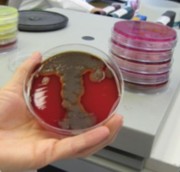
Pathogen Identification and Sensitivity
Infectious disease diagnostics allows for identification of pathogens and the risk they carry, as well as insight into their susceptbility to antimicrobial therapy. Currently, diagnostics lags behind treatments. There is a huge need to focus on this area. Infectious disease diagnostics are most often done in laboratories in tertiary care settings, but can also be done in point-of-care settings such as family doctor's offices, pharmacies, community centres, or mobile clinics.
Culture and Staining (C & S)
 Culture provides expansion of bacterial numbers, helping with their identification and evaluation of sensitivity to various antibiotics.
Culture provides expansion of bacterial numbers, helping with their identification and evaluation of sensitivity to various antibiotics.
Bacterial samples can be stained using tissue (pus, sputum, etc) or culture (urine, blood, etc). The gram stain is the cornerstone of bacterial staining. Other common stains include the Giemsa stain (malaria and other parasites), the Ziehl-neelsen stain (for M. tuberculosis and other acid-fast organisms), and others.
The University of Utah's excellent WebPath staining tutorials provide much information about staining techniques.
Molecular and Biochemical Tecnhiques
Molecular and biochemical techniques allows sophisticated and rapid indentification of pathogens. There is a strong move towards using PCR, ELISA, Western blotting, and other techniques. We are limited only by our willingness to learn and adopt these extremely powerful approaches.